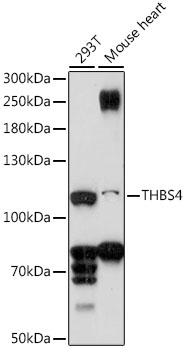-
Product Name
THBS4 Polyclonal Antibody
- Documents
-
Description
Polyclonal antibody to THBS4
-
Tested applications
WB
-
Species reactivity
Human, Mouse
-
Alternative names
THBS4 antibody; TSP-4 antibody; TSP4 antibody; thrombospondin-4 antibody
-
Isotype
Rabbit IgG
-
Preparation
Antigen: Recombinant fusion protein containing a sequence corresponding to amino acids 27-300 of human THBS4 (NP_003239.2).
-
Clonality
Polyclonal
-
Formulation
PBS with 0.02% sodium azide, 50% glycerol, pH7.3.
-
Storage instructions
Store at -20℃. Avoid freeze / thaw cycles.
-
Applications
WB 1:500 - 1:2000
-
Validations

Western blot - THBS4 Polyclonal Antibody
Western blot analysis of extracts of various cell lines, using THBS4 antibody at 1:1000 dilution.Secondary antibody: HRP Goat Anti-Rabbit IgG (H+L) at 1:10000 dilution.Lysates/proteins: 25ug per lane.Blocking buffer: 3% nonfat dry milk in TBST.Detection: ECL Enhanced Kit .Exposure time: 150s.
-
Background
Adhesive glycoprotein that mediates cell-to-cell and cell-to-matrix interactions and is involved in various processes including cellular proliferation, migration, adhesion and attachment, inflammatory response to CNS injury, regulation of vascular inflammation and adaptive responses of the heart to pressure overload and in myocardial function and remodeling. Binds to structural extracellular matrix (ECM) proteins and modulates the ECM in response to tissue damage, contributing to cardioprotective and adaptive ECM remodeling. Plays a role in ER stress response, via its interaction with the activating transcription factor 6 alpha (ATF6) which produces adaptive ER stress response factors and protects myocardium from pressure overload. May contribute to spinal presynaptic hypersensitivity and neuropathic pain states after peripheral nerve injury. May play a role in regulating protective astrogenesis from the subventricular zone (SVZ) niche after injury in a NOTCH1-dependent manner (By similarity).
Related Products / Services
Please note: All products are "FOR RESEARCH USE ONLY AND ARE NOT INTENDED FOR DIAGNOSTIC OR THERAPEUTIC USE"
